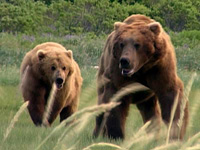Grizzlies flourish in Rocky Mountains

Grizzly bears that were nearly extinct last century are back now. Their population is expending its area in the northern Rocky Mountains and mauling hunters who stumble across them in the wild.
While state and federal officials laud the bear's comeback, others say it is time to lift the remaining protections that helped them recover. They point to recent grizzly encounters as evidence.
"We've got grizzly bears eating people who come here to hunt," said Vic Workman, Montana Fish, Wildlife and Parks commissioner, who fended off a grizzly during a Nov. 25 hunting trip in northern Montana. "It's getting out of whack. We've got too many bears."
The grizzly charged after Workman stumbled upon it as it guarded a fresh deer carcass. Workman fired a shot from his rifle and was not injured. The bear ran off.
If hunters could kill some bears, Workman said, the rest of the population would learn to avoid humans.
The biologist in charge of restoring grizzlies acknowledges they appear to be on track toward recovery in some areas. In central and western Montana, for example, they have expanded their range by more than 2,300 square miles (6,000 square kilometers) in the last two decades.
But Christopher Servheen, grizzly recovery coordinator with the U.S. Fish and Wildlife Service, said it would take at least five more years of research to show the bear's progress is not fleeting.
Recovery is not just measured by the number of bears, he added. Also important is how widely they are distributed, whether females breed at an adequate rate, and how many are killed crossing highways or in other human-related accidents.
Workman's close call was the latest in a string of bear attacks and near misses this year in Montana and portions of Idaho and Wyoming near Yellowstone National Park. While there is no comprehensive data on grizzly-human conflicts, an Associated Press tally shows at least a dozen grizzly bear attacks reported since April.
Seven people were injured, some severely. At least five grizzlies were killed, either during the attacks or later by wildlife agents.
Servheen said it would be a mistake to link the run-ins to a decision on whether protections should be lifted.
"That wouldn't have changed what happened to Mr. Workman in any way shape or form," he said. "If you walk close to a bear that's over a carcass, it doesn't care if it's a delisted bear or not. It's going to charge."
One bear population is already moving toward possible hunting. An estimated 600 grizzlies in and around Yellowstone early this year became the first of their species in the lower 48 states to lose their threatened species status.
Even there, a hunt is at least a year away and would likely be capped at just a few animals, said Chris Smith, chief of staff for the state wildlife department.
Conservation groups say more could be done to prevent bear-human conflicts without simply culling the grizzlies' population. Craig Kenworthy, conservation director for the Greater Yellowstone Coalition, noted that spikes in bear attacks generally coincide with a shortage of food or other unfavorable environmental conditions.
This year, for example, drought in the Yellowstone area forced bears to roam farther and stay out longer in search of berries, insects and other food before winter.
"What we don't want to do is have a hunt and knock the numbers down and then find out we're still having the same number of conflicts," Kenworthy said.
His group recently filed a lawsuit seeking to reverse the delisting of Yellowstone-area grizzlies.
Smith said his agency would await the outcome of the litigation before drafting any plans for a grizzly hunt.
Subscribe to Pravda.Ru Telegram channel, Facebook, RSS!


